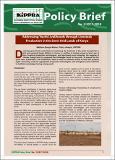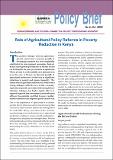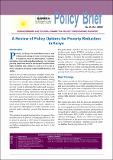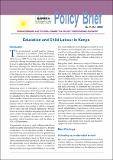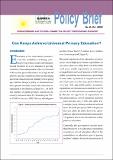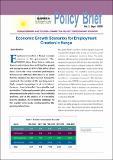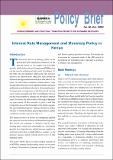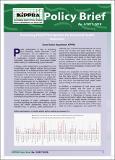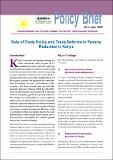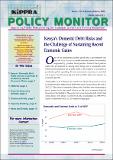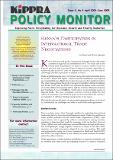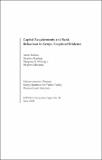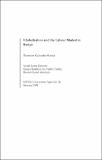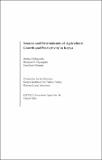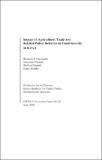3. KIPPRA Research Publications: Recent submissions
Now showing items 621-640 of 709
-
Policy Brief No. 2 of 2004 on Fiscal Strategies and Poverty in Kenya: Agenda for Reform
(The Kenya Institute for Public Policy Research and Analysis (KIPPRA), 2004)Historically, Kenya’s development policy has combined the objectives of economic growth with equity and poverty reduction. Although there were improvements in social welfare indicators in the late 1980s, these achievements ... -
Policy Brief No. 6 of 2004 on Role of Agricultural Policy Reforms in Poverty Reduction in Kenya
(The Kenya Institute for Public Policy Research and Analysis, 2004)This policy brief is based on a study on the Role of agricultural policy reforms in poverty reduction: Implication for economic recovery strategy for wealth and employment creation. The aim of the study is to contribute ... -
Policy Brief No. 9 of 2004 on a Review of Policy Options for Poverty Reduction in Kenya.
(The Kenya Institute for Public Policy Research and Analysis, 2004)Poverty in Kenya is multidimensional and widespread among all socio-economic groups. It manifests itself in deprivation, isolation, alienation, insecurity and despondency. Low-income poverty manifests itself in the form ... -
Policy Brief No. 7 of 2004 on Education and Child Labour in Kenya
(The Kenya Institute for Public Policy Research and Analysis, 2004)This policy brief is based on a study on Education and child labour in Kenya. The study investigates the child labour-schooling trade-off owing to the fact that those children who are not in school end up in child labour. ... -
Policy Brief No. 8 of 2004 on Can Kenya Achieve Universal Primary Education
(The Kenya Institute for Public Policy Research and Analysis, 2004)Education is the main factor associated with the probability of being poor. Improving educational performance should therefore be a core element in poverty reduction. Since independence, the Government of Kenya has given ... -
Policy Brief No. 1 of 2004 on Economic Growth Scenarios for Employment Creation in Kenya
(The Kenya Institute for Public Policy Research and Analysis, 2004)Employment creation in Kenya is a major concern to the government. The 1998/99 Labour Force Survey estimates Kenya’s active labour force at 10.5 million people, and unemployment at 14.6% of the active labour force. Given ... -
Policy Brief No. 10 of 2004 on Interest Rate Management and Monetary Policy in Kenya
(The Kenya Institute for Public Policy Research and Analysis, 2004)The Economic Recovery Strategy (ERS) for the period 2003-2007 emphasizes on the role of the private sector as the engine for economic growth, while the Investment Programme (2003) points out the need to enhance private ... -
Policy Brief No. 3 of 2004 on Tax Reform Experience and the Reform Agenda for Kenya
(The Kenya Institute for Public Policy Research and Analysis, 2004)Unlike many sub-Saharan African countries, Kenya is a high tax yield country with a tax to GDP ratio of over 20 percent. A review of Kenya’s tax reform experience reveals that generally, levels of tax rates have been reduced ... -
Policy Brief No. 5 of 2004 on Corruption, Firm Growth and Export Propensity: Findings from Kenyan Manufacturers
(The Kenya Institute for Public Policy Research and Analysis, 2004)Surveys of manufacturing firms over the last decade have shown that business persons based in Kenya view corruption as a major hurdle to corporate pursuit. Other governance-related surveys have also concluded that Kenya ... -
Policy Brief No. 4 of 2004 on Role of Trade Policy and Trade Reforms in Poverty Reduction in Kenya
(The Kenya Institute for Public Policy Research and Analysis, 2004)Kenya’s economic development strategy has often used trade policy as part of an assortment of policies towards achieving economic growth and poverty reduction. More recent trade liberalization efforts have aimed at improving ... -
Policy Brief No. 01 of 2004 on Vision and Long Term Development Strategy for Kenya's Tourism Industry
(The Kenya Institute for Public Policy Research and Analysis, 2004)The capacity of the country to offer luxury tourism has been largely compromised crowding, over-development of facilities, competition for tourists, insecurity, poor infrastructure in general, and environmental ... -
Policy Monitor, Issue 1 No. 3, January-March 2004 on Kenya's Domestic Debt: Risks and the Challenge of Sustaining Recent Economic Gains
(The Kenya Institute for Public Policy Research and Analysis, 2004)One of the fundamental public goods that a government can provide to its citizens is a stable macroeconomic environment supported by prudent fiscal policies. Prudent fiscal policies enable the government to, among other ... -
Policy Monitor, Issue 2 No. 4, April 2004-June 2005 on Kenya's Participation in International Trade Negotiations
(The Kenya Institute for Public Policy Research and Analysis, 2004)Trade negotiations play a key role in increasing international market access for exports. Kenya has pursued global integration through trade with other countries at regional and international level. The main aim in ... -
Discussion Brief Issue No. 02 of 2004 on Impact of Tourism on the Environment in Kenya
(The Kenya Institute for Public Policy Research and Analysis (KIPPRA), 2004)Tourism is a leading economic activity in Kenya, being the third largest foreign exchange earner after tea and horticulture. Since 1990, particularly since the second half of the 1990s, Kenya's tourism industry ... -
Discussion Paper No. 32 of 2004 on User Charges and Utilization of Health Services in Kenya
(The Kenya Institute for Public Policy Research and Analysis, 2004)This paper uses data from Kenya to examine the role of user charges and quality of health services in determining the choice of healthcare providers. We find that an increase in the price of public health services diverts ... -
Discussion Paper No. 33 of 2004 on Poverty and Employment in Kenya
(The Kenya Institute for Public Policy Research and Analysis, 2004)At the time of independence in 1963, the Government of Kenya identified illiteracy, disease, ignorance and poverty as the main problems to be addressed in the post-independence era. In spite of the antipoverty measures ... -
Discussion Paper No. 36 of 2004 on Capital Requirements and Bank Behaviour in Kenya: Empirical Evidence
(The Kenya Institute for Public Policy Research and Analysis (KIPPRA), 2004)This study analyses the impact of risk-based capital requirements on bank risk and capital levels. In the past, regulators placed much attention on increase in bank capital without much consideration of the corresponding ... -
Discussion Paper No. 31 of 2004 on Globalisation and the Labour Market in Kenya
(The Kenya Institute for Public Policy Research and Analysis (KIPPRA), 2004)This paper analyses the effect of globalisation on the labour market outcomes in Kenya using micro datasets complemented with secondary data. The analysis shows that during the economic reform period (1970s to 1990s), ... -
Discussion Paper No. 34 of 2004 on Sources and Determinants of Agricultural Growth and Productivity in Kenya
(The Kenya Institute for Public Policy Research and Analysis (KIPPRA), 2004)Agriculture is the most important sector in the Kenyan economy given its contribution to employment, foreign exchange, food, and its linkages with other sectors of the economy. Indeed, the sector’s performance directly ... -
Discussion Paper No. 39 of 2004 on Impact of Agricultural Trade and Related Policy Reforms on Food Security in Kenya
(The Kenya Institute for Public Policy Research and Analysis (KIPPRA), 2004)Kenya’s agricultural sector has undergone various changes emanating from policy reforms over the years. These reforms, which occurred from the late 1980s to the early 1990s, were aimed at reducing government involvement ...

